Why is New Year needed? A holiday in a child's life. New Year holiday history
The holidays give us an extra day off, an opportunity to do our own interesting things and spend an extra day at home with our family.
They say that the Russian people love to have a good rest and take a walk. And they say it for a reason! If we look back at Russian culture, we will see how many holidays there are. Celebration is an art, a special skill that has unfortunately been lost in our modern culture.
The anticipation of the holiday, the preparation for it, the celebration itself, and then the memories of it should be filled with joy and delight!
There are four main holidays of the seasons: autumn holiday— Harvest day, winter — New Year and Christmas, spring - Easter and summer - Ivan Kupala Day.
It turns out that all these holidays are important in the development of a child. Annual holidays, since they are always repeated the same way, help the baby create an idea of time.
Time passes... Minute by minute, day by day, year by year. To understand the meaning of time, you need to see the cyclical nature of our lives. The child observes a repeating circadian rhythm, seasonal phenomena and draws conclusions. For time to become an object for us, not only the repetitions of day-night, summer-winter, but also the events accompanying them are important. For example, how is night different from day? Besides the fact that it is dark at night and light during the day, we are different times We behave differently during the day: during the day we play, walk, eat; at night, turn off the lights and sleep.
Family holidays help shape these ideas and add joyful emotions and awareness.
Let's figure out how best to spend the New Year for a child to make the holiday as interesting and useful for his development as possible.
New Year and Christmas - these are winter holidays. This is the time of a person's inner life. When we communicate less actively with our environment, we spend more time at home with our family and alone with ourselves.
Holiday symbols
In all holidays, stability and traditions are important for children.
It is very important for a child to mark the beginning of the holiday with something significant. Usually on December 31st we set the table and on New Year's Eve Santa Claus brings gifts under the Christmas tree. In a week we celebrate Christmas, and in another week we celebrate Old New Year.
It is difficult to explain to a small child what day the gifts will appear under the Christmas tree. Therefore, it will be clearer for the baby if we prepare for the holiday during the day. Cleaning, cooking, table setting. It’s good if we decorate the tree on December 31st, and on the same night gifts will appear under the tree. Then the tree, according to tradition, stands until the feast of Epiphany.
You can also mark the celebration with special dishes that are given only once a year. The place of the feast, that is, the table is set on this day, not in the kitchen, as usual, but in a large room. And also some main dish that is prepared once a year - on the New Year's holiday.
Life in a fairy tale
Remember any New Year's fairy tale. It will be about good and evil. Father Frost and Snow Maiden usually meet with Baba Yaga; the fairy tale shows different qualities of a person’s character. Honesty, generosity and courage fight against greed, lies and cowardice. Good always wins.
Children are shown the value and benefits of certain qualities. And for the child to perceive this information, he needs to immerse himself in the experience. Feel, live, believe...
Quite often, kindergartens and schools hold demonstration performances for parents. The child is taken to the middle of the assembly hall and he recites a memorized poem. Children often worry, get lost, forget... The child’s thoughts concentrate on something else, and the meaning of the holiday is lost.
At any holiday, children just need to live in a fairy tale, and not work out a performance program planned by someone. The child participates in the program as much as he is ready for it.
On every New Year's party you can see a baby being pushed by his mother or grandmother into a round dance: “Well, why are you sitting in your arms? Go have fun with everyone!”
All kids are different. And not everyone needs to be at the epicenter of events. A child can live a fairy tale in his mother’s arms.
I would like to especially note the fact that most children under three years of age are afraid of Santa Claus, various clowns and other dressed-up performers. This is not nonsense, but features of mental development. Kids are not yet able to perceive this game. Therefore, at this age it is not recommended to invite Santa Claus home. It’s best if the mother herself dresses up as the Snow Maiden and celebrates the holiday. If you nevertheless come to a carnival holiday, let your child spend it next to you, do not push him to recite rhymes, dance in a circle or receive gifts if he does not want to.
New Year's mode
New Year's Eve is unusual. They prepare for it all day, clean up, and set a beautiful table.
But for a small child, the evening ends the same as always: he gets ready for bed and goes to bed at the usual time.
To make it easier for your child to fall asleep on such an exciting day, you need to create a festive bedtime ritual. It turns out something like this: first a fun feast, then you can take the right boot, put it under the Christmas tree, mom will tell you about it at night New Year's tale and the baby falls asleep waiting for a miracle. While the child is small, he does the whole ritual together with his mother, because the kids still don’t understand what needs to be done, why and how.
What to give to a child?
Of course, when choosing a gift, each family is guided by its capabilities and desires of the child. Here I want to talk about gifts accepted in our Russian traditions, and you can decide for yourself how to use it.
It is believed that the custom of placing boots under the Christmas tree came to us from America. In fact, it's the other way around. Traditionally in Russia, on New Year's Eve, various sweets and fruits were poured into a child's boot with a slide. In the morning the child ran to the tree and took his gift. He has the right to do whatever he likes with it.
All the big gifts were given at Christmas. For a child, this holiday is very different from the New Year: the tree has been in the house for a week, but on January 6, on Christmas Eve, they cleaned the house, gave the house a festive decoration, and set the table.
It used to be believed that the Guardian Angel brought gifts at Christmas. At night, the child’s bed can be decorated with tinsel and unusual sparkles, as if leaving traces of an angel. Same as in New Year's Eve, sweets and fruits were poured into the boot, and placed next to great gift. It always included a book, a toy, a piece of clothing and surprises. This gift was made multi-layered and interesting. For example, we opened a book and a sticker fell out; Somewhere in the box there was an envelope with a letter or a toy. A child can spend three days with such a gift, discovering more and more surprises.
The Old New Year is celebrated from January 13 to 14, this is Vasilyev's evening. After all, our Santa Claus is Moroz Vasilievich. The days of the old New Year and before Epiphany are usually the frostiest days of the year. From Santa Claus, a small warm gift was added to the traditional boot. For example, mittens, a hat, a scarf or socks.
Gifts from Santa Claus and Guardian Angel are given until adulthood. And the secret that their parents play their role is never revealed. Even if a fifteen-year-old boy asks if Santa Claus exists, mom and dad should answer: he does!
And this is not a lie. This is a fairy tale, faith in a dream.
To summarize all of the above, I will repeat. The holiday should include a combination of:
- Stability - this concerns preparation for the evening, the Christmas tree, routine, holiday rituals;
- Surprises - various games, gifts, surprises, fairy tales!
Understanding the characteristics of the child’s psyche and a creative approach will help you create a truly unforgettable holiday for the whole family!
New Year's holiday
(holiday traditions)
New Year- a holiday celebrated by many peoples in accordance with the accepted calendar, occurring at the moment of transition from last day year on the first day of the next year. The custom of celebrating the New Year already existed in Ancient Mesopotamia, presumably in the third millennium BC. The beginning of the year on January 1 was established by the Roman ruler Julius Caesar in 46 BC. Nowadays, most countries celebrate the New Year on January 1, the first day of the year according to the Gregorian calendar. Some countries, such as China and other countries in Southeast Asia, celebrate the New Year according to the lunar calendar - between January 21 and February 21, i.e. much later than us. And it is no coincidence that the literal translation of Chinese New Year is called Spring Festival. Jewish New Year - holiday Rosh Hashanah(chapter of the year) is celebrated 163 days after Passover(no earlier than September 5 and no later than October 5).
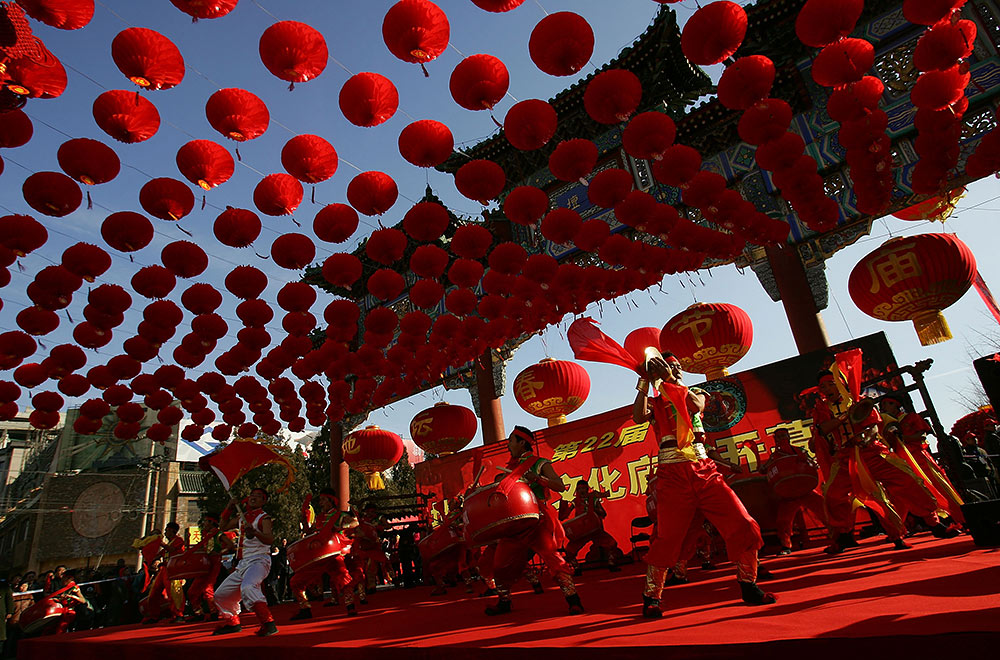
Celebrating Chinese New Year
For Muslims, on the first day of the holy month Muharram new year is coming Hijri (migration of the prophet Muhammad from Mecca to Medina) . 1 Muharram is not included in the list of Islamic holidays and, accordingly, in most Muslim countries, the New Year is not celebrated as a holiday in the secular sense. On this day, a sermon is read in mosques dedicated to the move of the Prophet Muhammad from Mecca to Medina in 622 - the starting point of the Muslim lunar calendar.

The traditions of the modern New Year holiday in Russia (as well as in Ukraine and Belarus) are well known to us. Despite the general similarity of the celebration (primarily in the Christian world), some countries have their own national characteristics and color. So, for example, in England In addition to the Christmas tree, the house is decorated with mistletoe branches. There are even mistletoe bouquets on lamps and chandeliers, and, according to custom, you can kiss a person standing in the middle of the room under a mistletoe bouquet.

Mistletoe wreath
IN Italy On New Year's Eve it is customary to get rid of old things. And in Spain At midnight it is customary to eat 12 grapes.
In France Father Frost - Pere Noel- comes on New Year's Eve and leaves gifts in children's shoes. The one who gets the bean baked into the New Year's pie receives the title of "bean king", and on the festive night everyone obeys his orders. Wooden or clay figurines - santons- placed near the Christmas tree.
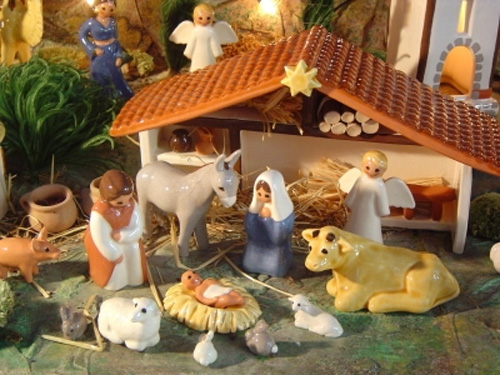
Santons
IN Sweden before the New Year, children choose the queen of light Lucius. She is dressed up in white dress, a crown with lit candles is put on the head. Lucia brings gifts for children and treats for pets: cream for the cat, a sugar bone for the dog, and carrots for the donkey. The main symbol of the New Year for some time now Gevli goat- in 1966, one citizen of Gävle came up with the idea to remind in this way of the Christmas character of the local epic, and he built it from straw in the city square. However, on New Year's Eve it was burned by hooligans. Since then, this action has become a tradition and the Swedes loved it so much that they began to practice it in other cities. In 1985, the Gevle goat was included in the Guinness Book of Records, its dimensions were: height 7.6 m, length 7 m; The stuffed animal weighed 3.6 tons.
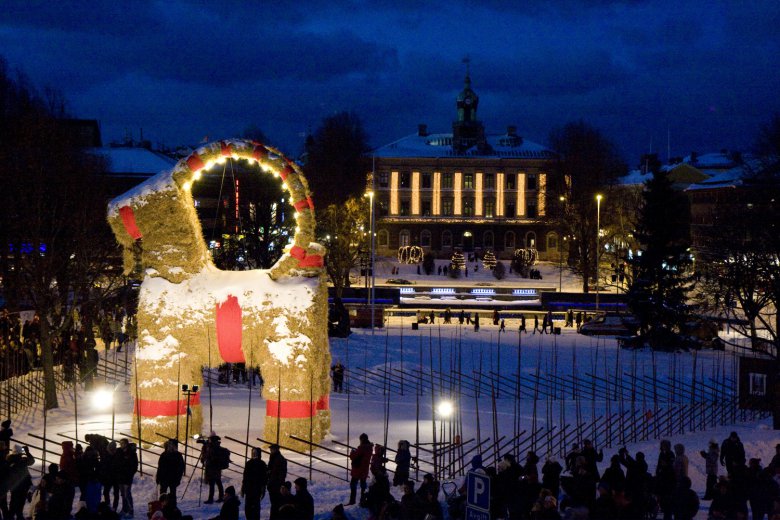
Gevle goat
IN Bulgaria on New Year's Eve after a feast, young people make dogwood sticks ( survachki). Survachka is decorated with red thread, heads of garlic, nuts, coins, prunes and dried fruits. They go to visit guests with survachkas, enter houses and “knock” them on the backs of the owners. Such “beatings” promise good luck, health and prosperity to the house. When people gather at festive table, the lights in all houses are turned off for three minutes. These minutes are called “minutes of New Year’s kisses,” the secret of which is preserved by darkness.

Children with survachki
IN Colombia main character New Year's carnival - Old year - walks around on high stilts and tells funny stories to children. Papa Pascual- Colombian Santa Claus - arranges fireworks.
On Cuba Before the New Year, all jugs, buckets, basins and bowls are filled with water and at midnight the water is poured out of the windows. So they wish the outgoing year a path as bright as water. While the clock strikes 12 times, you need to eat 12 grapes, and then goodness, harmony, prosperity and peace will accompany a person all year.
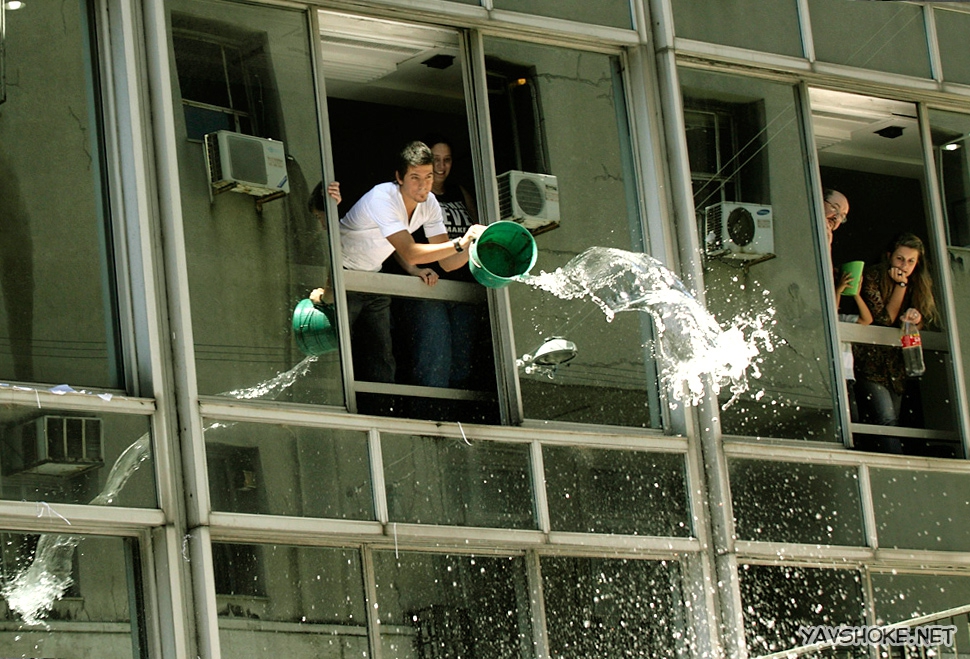
IN Mexico The New Year is celebrated with the fire of festive fireworks, firing from rocket launchers, and the ringing of special New Year's bells. And children are given delicious gingerbread dolls at midnight.
IN Japan On New Year's Eve the bells are rung 108 times. Each strike of the bell corresponds to one of the vices. There are six of them in total: greed, stupidity, anger, frivolity, indecisiveness and envy, but each vice has 18 different shades, which makes a total of 108.
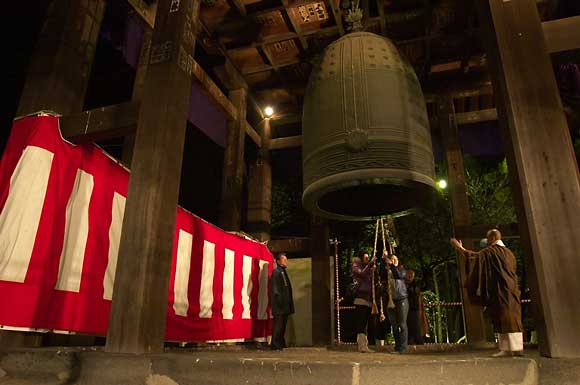
IN Myanmar(Indochina) The New Year comes at the hottest time of the year, so its arrival is celebrated with the so-called “water festival”, when people pour water on each other when they meet. The tradition of pouring water is a kind of wish for happiness in the New Year.

IN Turkey There is no custom to celebrate the New Year as such. This holiday is considered secular, it is not forbidden to celebrate it, but it is not recommended to organize noisy festivities all night; the Muslim clergy is critical of such celebrations. However, in large cities (Istanbul, Ankara), where many Europeanized Turks live, many families celebrate the New Year according to the Christian (Gregorian) calendar and have fun with the Turkish equivalent of Santa Claus - Noel Baba. Also in tourist cities by the sea, where many vacationers come at this time, it is customary to celebrate the New Year on a grand scale - they organize entertainment programs, parties, concerts, although mainly for tourists and not for local residents. The Turks themselves usually spend this holiday in front of a richly laid table (but without the attributes and gifts familiar to Europeans), watching holiday programs on TV all night long. And in the provinces and small settlements, almost everyone goes to bed on New Year’s Eve.
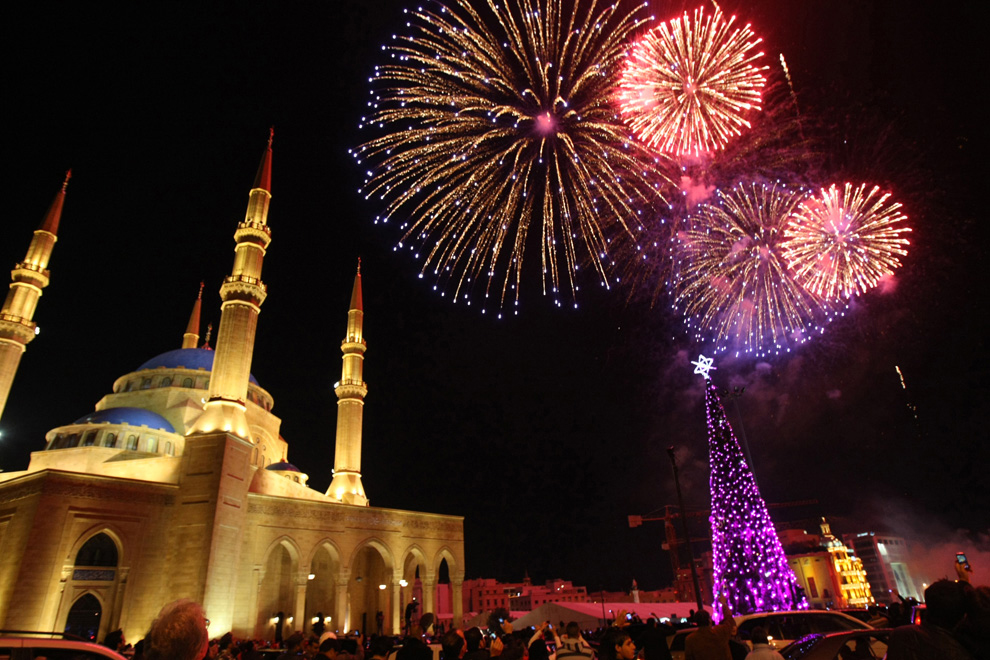
Turkish New Year “for tourists”
Jewish New Year ( Rosh Hashanah) celebrated for two consecutive days on the new moon of the autumn month Tishrei. On the first evening of Rosh Hashanah, it is customary to greet each other with a wish to be inscribed in the “Book of Life.” During the holiday meal, it is customary to dip the bread (usually a round challah) over which the blessing was recited, in honey so that the coming year will be sweet; There is also a custom of eating apples with honey on Rosh Hashanah.

Festive table for Rosh Hashanah
Chinese New year (celebrated in China and other East Asian countries) is the longest and most important holiday in Chinese lunar calendar. The first day of the New Year begins with the launch of fireworks and ends with the Lantern Festival. The origins of this holiday date back to ancient times, and in its current form it reflects symbolic respect for the myths, beliefs and traditions preserved in Chinese society. Their manifestation, for example, is the symbolic designation of the new year by one of the 12 animals, as well as a symbolic color associated with the theory of the “five elements”.
This holiday is marked by new hopes, thoughts and ideas. In our country, New Year is the most popular holiday. Already at the end of November, more than a month before the celebrations, we begin to prepare for the holiday. The holiday bustle is literally everywhere. Adults think about how to set the table and what gifts to give to children and loved ones. Children take part in various performances at school and kindergartens, stage skits, and learn holiday poems and songs. A mandatory attribute of the New Year is a Christmas tree. Not a single family will be left without a Christmas tree these days. The Christmas tree in each house is decorated differently, some put it up a week before the holiday, and others on the eve. The Christmas tree is decorated with various balls, garlands and toys. There are also homemade children's decorations on it, and maybe not children's ones, because the housewives are also trying. They usually put cotton wool under the tree, which means snow. Figures of Father Frost and Snow Maiden are placed on the “snow”. At night, while no one is in the room with the Christmas tree, Santa Claus brings gifts, carefully placing them under the Christmas tree, in the “snow.” After the striking of the Kremlin Chimes, everyone gets up from the table and runs into the room to see what Santa Claus gave them. Delighted with their gifts and congratulating each other on the New Year, people go out into the street, where they play snowballs, set off fireworks, and dance in circles. But it wasn't always like this. Years go by, morals change, traditions change. How did they celebrate the New Year in Russia before?
Until the 15th century, New Year was celebrated on March 1st, the winter solstice. Since the 15th century, the holiday has been celebrated on September 1st. Celebrating the New Year on January 1st began in Russia in 1700 by decree.
Our ancestors believed that on New Year's Eve various demons emerge from the underworld and walk through cities and villages, frightening the Orthodox people everywhere. From this very night until Epiphany, demons walk the earth, amuse themselves and do dirty tricks on people who forgot to fence their houses with a cross, which should have been depicted on the doors of the premises. What is the reason for this legend? They say that God was very happy when his son was born, and, unlocking all the doors, he let the devils out for a walk. The devils came up with countless sinful entertainments for the destruction of the human race, and light-minded youth succumbed to the machinations of evil spirits.
Scary, isn't it? This legend was created by pious people as a lesson for flighty youth. The fact is that on this holiday throughout vast Rus', young people took part in fortune-telling and various, not always highly moral, games. Fortune telling was a favorite pastime for young people. Fortune telling was customary at Christmas and Epiphany. But the most accurate fortune telling was New Year's. However, for fortune telling to be accurate, fortune tellers had to meet a number of conditions. It was necessary to tell fortunes without a belt, a cross and without a blessing. The main topic for fortune telling was marriage. Young people wondered who they would marry (who they would marry), how soon, and how their relationship would turn out. family life. Girls especially loved to tell fortunes. Guys, as a rule, knowing the girls’ favorite places for fortune-telling, tried to joke with them.
 Pious people considered any fortune-telling a sin. The only thing that could be worse is the masks. Wearing masks (hari) was considered indecent, especially for girls. Girls from religious families considered it shameful not only to wear such masks, but also to dress in costumes that were unusual for her age or gender. The person who put on the mask committed a grave sin. The only way to improve matters is to swim in an ice hole on the day of Epiphany. Despite the prohibitions and condemnations, young people always organized masquerades on New Year’s Day and entertained themselves and those around them.
Pious people considered any fortune-telling a sin. The only thing that could be worse is the masks. Wearing masks (hari) was considered indecent, especially for girls. Girls from religious families considered it shameful not only to wear such masks, but also to dress in costumes that were unusual for her age or gender. The person who put on the mask committed a grave sin. The only way to improve matters is to swim in an ice hole on the day of Epiphany. Despite the prohibitions and condemnations, young people always organized masquerades on New Year’s Day and entertained themselves and those around them.
The entertainment of the adult population was not as noisy and fun as that of the youth. These entertainments were primarily aimed at performances that did not contradict church canons. During the holidays, society lived with hopes and forebodings. They were especially acute in the peasant environment, where much depended on chance. All “adult” signs, customs and fortune telling boiled down to how to find out whether the New Year will be fruitful or not. For example, if the sky is starry on a holiday, there will be a lot of berries and mushrooms in the forest. And there were many such signs, we will definitely tell you about them on our website.



